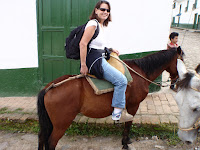 |
| Monument to Benkos Biohó, San Basilio de Palenque founder |
 |
| Sara arriving in Palenque via mototaxi |
I had wanted to visit Palenque, not far from Cartagena, ever since I read a little blurb about it shortly after I arrived here last October. Hard-working "Palenqueras", or women from Palenque, walk around Cartagena in their colorful dresses, selling fruit and sweets which they carry in bowls on their heads, and have become symbols of this city. What was the story of the town they're from?
"Palenques" ("walled cities"), were small towns founded by escaped slaves in the 1600s.
San Basilio de Palenque, about 50 km from Cartagena, was the first such town and the only one still in existence in Colombia. Most of the some 3,500 residents are direct descendants of these escaped slaves and they have a unique culture reflective of their African roots, including having their own language. The town has been
recognized by UNESCO as an important cultural space.
 |
| Me with Maria & a friend |
Sara was all for visiting Palenque and the adventure of getting there. We took a ~45 minute local bus from downtown to the bus terminal, then another ~45 minute bus trip to where the road to Palenque met the major "highway." From there you take a "mototaxi" the ~3 miles to Palenque itself. A mototaxi is a motorcycle that takes a paying passenger; no, it's not a legal business but they are widespread here on the coast. Having seen the mototaxis speeding dangerously through the jam packed streets of Cartagena, I never wanted to take one, but here it was our only option. I asked my helmetless driver for a helmet but there was none to be had. I will say that our drivers drove quite carefully and slowly over the partially paved/partially unpaved road in to Palenque and it wasn't so bad. Still, I don't anticipate taking one anytime soon in Cartagena.
 |
| El Maestro in front of his portrait |
There are a couple of Palenqueras who work outside of my school & I had asked one, Maria, for advice on how best to visit her town, knowing this would mean we'd end up with a guide, which was fine. She set us up with her daughter (who I didn't realize was only 13, but that's ok...) and had us start out at the "Maestro's" house, an older gentleman who leads
a Palenquero musical group that has traveled around the world, which we discovered when we met him. It was interesting, and quite a contrast, to hear him talk about his international travels while we were sitting in the back yard of his very humble home in this town which has only had electricity since the 1970s and where many people don't have running water.
 |
| The swimming slash laundry hole |
Our guide Liliana showed us the cultural center; the river where many wash their clothes as well as swim; the main square with a statue of the town's founder
Benkos Biohó, an escaped slave; the school; boxing area; and then took us to a restaurant where we had lunch. It was all quite interesting, even if there was not really much to see, but such an obviously different type of life. The people there live on agriculture (& Liliana was explaining to us what she learned in school about planting, harvesting, etc), tourism (there is a music festival every October when the town is packed), and the women who sell their fruit & sweets, etc. Such a different life.
More photos of Palenque
here.











